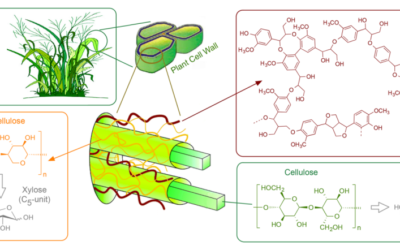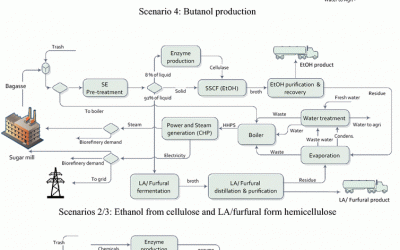
Biomass to Ethanol, Furfural and FT-Diesel (Results obtained for the selected biorefinery systems. Credit: ACS, Cherubini and Strømman)
Study Concludes That Best Way for a Biorefinery to Exploit Potential of Biomass Feedstock Is To Produce Ethanol, Furfural and FT-Diesel
18 March 2010 – Researchers at the Norwegian University of Science and Technology (NTNU) have developed a calculation procedure to estimate the maximum theoretical yields, as well as predictions of the conversion efficiencies in terms of mass, carbon, and energy efficiency, of selected biorefinery production chains.
Based on their calculations, they concluded that the best way to exploit all the potentials of a lignocellulosic biomass feedstock seems to be the production of ethanol from C6 polysaccharides, furfural from C5 polysaccharides, and FT-diesel from lignin. Combining the best feedstock with the most promising final products, their results show that up to 0.33 kg of bioethanol, 0.06 kg of furfural, and 0.17 kg of FT (Fischer-Tropsch)-diesel per kg of softwood can be produced and that mass, carbon, and energy conversion efficiencies of 56%, 70%, and 82%, respectively, can be achieved.
A paper on their study was published online 17 March in the ACS journal Energy & Fuels.
Francesco Cherubini and Anders Hammer Strømman selected lignocellulosic biomass as the raw material for their exercise. They calculated the carbon contents of lignocellulosic biomass components (cellulose, hemicellulose, and lignin) and products with the help of mathematical equations, and then modeled the chemical reactions for the conversion of feedstock to products using matrix algebra. The procedure determines the maximum amount of biofuels and/or biochemicals from biomass and the maximum mass, energy, and carbon conversion efficiency of the biorefinery pathway.
The team worked with three types of biorefinery systems:
- Biofuel-oriented biorefinery, where the products are ethanol (from C5 and C6 polysaccharides) and FT-diesel (from lignin).
- Chemical-oriented biorefinery, where the products are levulinic acid (from C6 polysaccharides), furfural (from C5 polysaccharides), and phenols (from lignin).
- Biorefinery based on gasification of the entire feedstock to produce FT-fuels.
Among their findings:
- The largest biofuel and biochemical yields are achieved with those feedstocks and components that have the lowest oxygen content and the highest carbon and hydrogen content, such as softwood. As a consequence, they note, the ethanol yield from C5/C6 polysaccharides is lower than that from the entire feedstock (which includes lignin), because sugars have a higher oxygen content.
- The possibility to exploit lignin for biofuel production purposes strongly affects the biofuel yield. In fact, there is a great potential for the production of FT-diesel from lignin, since this is the substrate with the highest carbon content,with hydrogen acting as the limiting factor.
- On a mass basis, ethanol has higher production potential than FT-diesel, but this margin strongly decreases if the energy content of the product is considered (ethanol has a heating value of 27 MJ/kg, whereas FT-diesel has a heating value of 42.7MJ/kg). The first-law energy efficiencies (defined as the ratio between the energy content of the products to the energy content of the feedstock) are ~90% for ethanol and ~85% for FT-diesel.
- Even with the lowest mass efficiency (41%, versus 54% for the biofuel-oriented biorefinery), the gasification system produces a carbon-rich product that has a much higher heating value than that of ethanol, and, therefore, the resulting carbon and energy conversion efficiencies are higher than that for the biofuel-oriented biorefinery.
An overall interpretation of these theoretical results leads to some important remarks concerning the best way in which the three biomass components of a lignocellulosic feedstock should be exploited. Regarding C5 sugars, yields of furfural are higher than those of ethanol; furthermore, C5 polysaccharides conversion to ethanol still must face non-negligible technological constraints and effective yields are lower than those of the C6 polysaccharides. Hence, regarding the biomass sugar fraction, the best treatment pathways seem to be the conversion of C6 sugars to ethanol and C5 sugars to furfural, from which a wide spectrum of biofuels and chemicals can be synthesized.
Concerning the third component of a lignocellulosic biomass feedstock, the lignin, the best alternative seems to be the conversion to FT-diesel via gasification…Even if almost half of the mass of the feedstock is lost (as CO2), the final products still have 70% of the carbon and 82% of the energy content of the raw materials.
…the best way to exploit all the potentialities of a lignocellulosic biomass feedstock seems to be the production of ethanol from C6 polysaccharides, furfural from C5 polysaccharides, and FT-diesel from lignin.
—Cherubini and Strømman
Resources
- Francesco Cherubini and Anders Hammer Strømman (2010) Production of Biofuels and Biochemicals from Lignocellulosic Biomass: Estimation of Maximum Theoretical Yields and Efficiencies Using Matrix Algebra. Energy Fuels, Article ASAP doi: 10.1021/ef901379s




